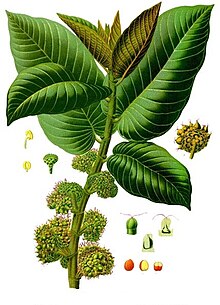|
Moraceae
The Moraceae—often called the mulberry family or fig family—are a family of flowering plants comprising about 38 genera and over 1100 species.[3] Most are widespread in tropical and subtropical regions, less so in temperate climates; however, their distribution is cosmopolitan overall. The only synapomorphy within the Moraceae is presence of laticifers and milky sap in all parenchymatous tissues, but generally useful field characters include two carpels sometimes with one reduced, compound inconspicuous flowers, and compound fruits.[4] The family includes well-known plants such as the fig, banyan, breadfruit, jackfruit, mulberry, and Osage orange. The 'flowers' of Moraceae are often pseudanthia (reduced inflorescences).  DescriptionOverallThe family varies from colossal trees like the Indian Banyan (Ficus benghalensis) which can cover five acres (two hectares) of ground, to Dorstenia barnimiana which is a small stemless, bulbous succulent 2–5 cm in diameter that produces a single peltate leaf on a 4–15 cm petiole. These two species have an approximately one billion fold difference in weight.[5][6] FlowersThe individual flowers are often small, with single whorled or absent perianth. Most flowers have either petals or sepals, but not both, known as monochlamydeae, and have pistils and stamens in different flowers, known as diclinous. Except for Brosimum gaudichaudii and Castilla elastica, the perianth in all species of the Moraceae contain sepals. If the flower has an inflexed stamen, then pollen is released and distributed by wind dispersal; however, if the stamen is straight, then insect pollination is most likely to occur. Insect pollination occurs in Antiaropsis, Artocarpus, Castilla, Dorstenia, Ficus, and Mesogyne.[7] LeavesThe leaves are much like the flowers when analyzing diversity. The leaves can be singly attached to the stem or alternating, they may be lobed or unlobed, and can be evergreen or deciduous depending on the species in question.[citation needed] The red mulberry can host numerous leaf types on the same tree. Leaves can be both lobed and unlobed and appear very different, but coexist on the same plant.[8] Fruits and seedsPlant species in the Moraceae are best known for their fruits. Overall, most species produced a fleshy fruit containing seeds. Examples include the breadfruit from Artocarpus altilis, the mulberry from Morus rubra, the fig from Ficus carica, and the jackfruit from Artocarpus heterophyllus.[9][10] TaxonomyFormerly included within the now defunct order Urticales, recent molecular studies have resulted in the family's placement within the Rosales in a clade called the urticalean rosids that also includes Ulmaceae, Celtidaceae, Cannabaceae, and Urticaceae. Cecropia, which has variously been placed in the Moraceae, Urticaceae, or their own family, Cecropiaceae, is now included in the Urticaceae.[11] Dioecy (having individuals with separate sexes) appears to be the primitive state in Moraceae.[9] Monoecy has evolved independently at least four times within the family. PhylogenyModern molecular phylogenetics suggest these relationships:[11][9][10][12]
Tribes and generaMoraceae is comprised 48 genera[2] in seven tribes.[13][14]
Other genera accepted by Plants of the World Online as of April 2024[update]:
Fossil genera and speciesIn addition to the living species, a number of fossil genera have been ascribed to the family:[15]
EvolutionWhile the fossil record of Moraceae goes back to the late Cretaceous, molecular clock estimates suggest that the family had begun to diversify by the mid-Cretaceous, with some major clades emerging during the Tertiary period.[12] DistributionMoraceae can be found throughout the world with a cosmopolitan distribution. The majority of species originate in the Old World tropics, particularly in Asia and the Pacific islands.[16] See alsoReferences
External linksWikispecies has information related to Moraceae. Wikimedia Commons has media related to Moraceae. |
|||||||||||||||||||||||||||||||||||
